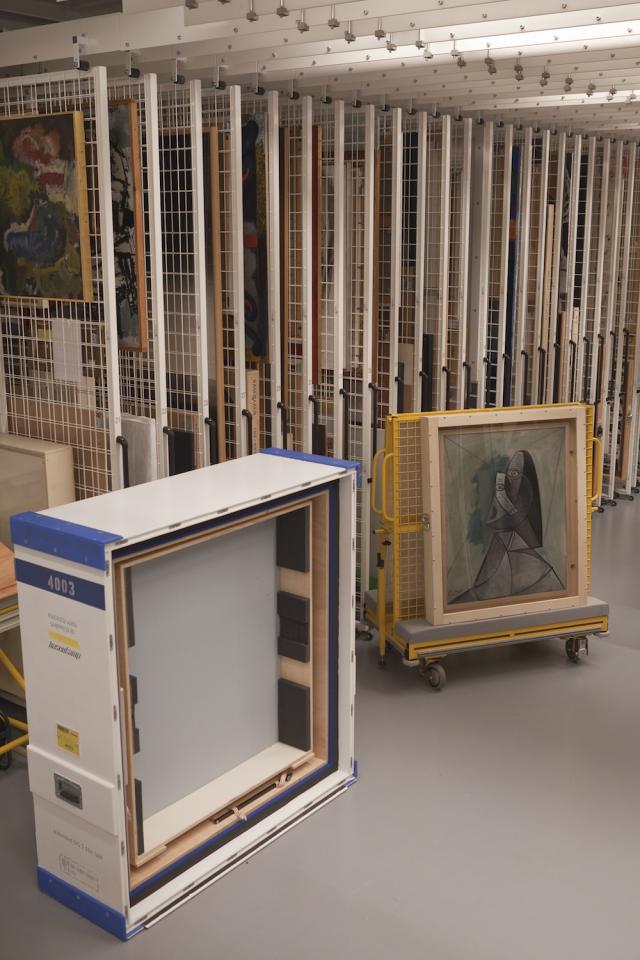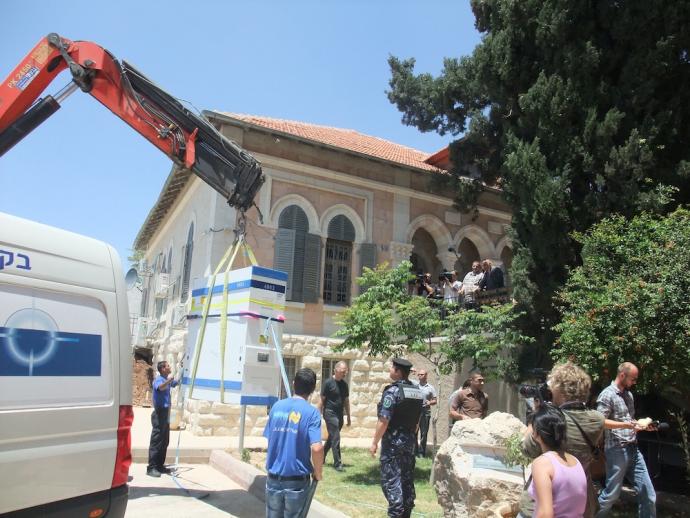from pastelegram.org, June 2011 – April 2014
Picasso in Palestine
The project Picasso in Palestine involves a rather simple and standard process frequently undertaken by most international museums. The International Academy of Art Palestine (IAAP) borrowed Pablo Picasso’s Buste de Femme (1943) from the Van Abbemuseum in Eindoven, Holland. Museum loans are nothing new, but because the IAAP is in Ramallah, The West Bank—territory of contested sovereignty—this process became deeply complex as well as a subject for a much larger artwork that encompasses a painting and the social forces that surround it.

Preparing Buste de Femme for transport at the Van Abbemuseum in Eindoven, Holland. Photograph by Perry van Duijnhoven.
Khaled Hourani, an artist and the artistic director of the IAAP, conceived of the project but his students ultimately chose the specific painting by Picasso. Hourani sent the loan request in 2009, and from that moment began the difficulty of navigating the questions of security and transportation to an occupied territory.1 It took two years of intense negotiations with art shippers and insurance companies as well as research into the intricacies of the Oslo Accords to set up the first instance of a Western modernist icon being transported across the Green Line and publicly exhibited in Palestine.
The painting was transported from Eindoven to Amsterdam and then Tel Aviv. Escorted by Israeli police to the Qalandia checkpoint, the painting was then driven for three miles without Israeli or Palestinian police due to stipulations connected to the Oslo Accords. Hourani and his fellow organizers invited international media to follow the painting, thinking that this added level of constant surveillance would increase the painting’s security. Finally, in Ramallah the painting came under the armed guard of Palestinian police.
This degree of scrutiny of the process of crossing the Green Line reveals many things, but two in particular. First, it shows the radical difference between the way that Buste de Femme, a Dutch-owned painting made by a Spaniard, was treated in crossing through the Qalandia checkpoint and the conditions under which thousands of Palestinians experience this crossing daily (an experience much less protected or valued for them). The painting is after all a portrait, and as such it symbolizes the body, thus its transport echoes the travel of a subject across the Green Line. Second, the elaborate process of security and transfer over the border tellingly highlighted the massive political distinctions between Israel proper and the West Bank, despite the settlers’ and the right-wing Israelis’ references to the area as Yehuda and Shomron—an attempt to signify its integration with the historic “Land of Israel.”

Buste de Femme's arrival at the International Academy of Art Palestine, Ramallah. Courtesy of Van Abbemuseum.
The painting went on exhibit in Ramallah in a specially constructed and humidity-controlled room inside the IAAP to great fanfare. Salam Fayyad, the Prime Minister of the Palestinian Authority, visited the exhibition on the day of its opening on June 24 along with scores of international media and Israeli and Palestinian culturati. Following the opening was Picasso Talks, a series of programs including lectures and panels about the painting held in Ramallah, East Jerusalem and Gaza. The Al Ma’Mal Foundation in East Jerusalem had an exhibition of documentation connected to Picasso in Palestine. While many Israelis visited this tandem exhibition, most Palestinians living in the West Bank—including Hourani—could not attend due to Israeli travel restrictions.
One intellectual to attend the activities surrounding Picasso in Palestine was Slavoj Žižek, the famous Slovenian cultural theorist. This video below encapsulates an important element of the project: the discourse that surrounds an art object and its conditions of display. Žižek sits in the yard outside the IAAP, conversing casually with Hourani and Remco de Blaaij, a curator from the Van Abbemuseum, over cups of coffee and fruit plates.
This Youtube clip is in many ways a typical example of conversations in Palestine, somewhat informal but filled with meaning. Soon we will see a more polished filmic account of the project: Rashid Masharawi is making a documentary about the process of planning, transporting and exhibiting the work. After all, this whole process is in many ways the work of art that is the object of the project. The film, which will address all of the ways that art, politics and geography collide with Picasso in Palestine, is set to release in 2012.
One issue raised in this wide-ranging conversation about the project was the question of normalizing the Israeli occupation. “Normalizing” refers to the oft-discussed problem for Palestinians and Palestinian solidarity activists: if Palestinians start to build architecture, economic structures, institutions and cultural projects, they run the risk of surrendering to the occupation as permanent. But Picasso in Palestine was carefully orchestrated not to offer solutions but rather to ask questions. What kind of museum does Ramallah or the Palestinian Authority need or want? What artworks are the most appropriate? And given the historic relationship between museums and nationalism, how should the Palestinian people be represented by cultural institutions? The task left over is for others to address these questions in which art and politics are inextricably intertwined.
- 1. In many cases, museums would hesitate or refuse to allow a work of theirs to enter a politically unstable territory simply because of an aversion to risk. But the Van Abbemuseum went along with this process and as a result revealed what is at stake when someone or something crosses a border like the Green Line.